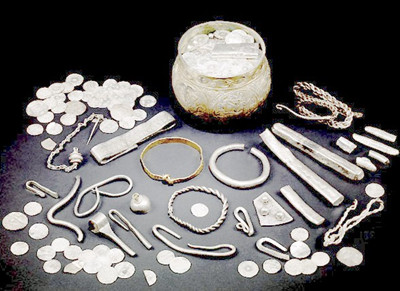The hoard pitches us into a key moment in the history of England, when an Anglo-Saxon King-Athelstan-at last defeated the Viking invaders and built the beginnings of the kingdom of England. Above all, it shows us the range of contacts enjoyed by the Vikings while they were running northern England. These Scandinavians were tremendously well connected, as the historian Michael Wood makes clear:
這一寶藏帶我們進人了英格蘭歷史上的關鍵時刻:盎格魯-撒克遜國王阿瑟斯坦終于擊敗了維京入侵者,建立了英格蘭王國。當然,它們首先表明了維京人當年統治英格蘭北部時的貿易范圍。他們與外界接觸十分頻繁,如歷史學家米歇爾伍德所說:
"There's a Viking arm-ring from Ireland, there's coins minted as far away as Samarkand and Afghanistan and Baghdad. And this gives you a sense of the reach of the age; these Viking kings and their agents and their trade routes spread across western Europe, Ireland, Scandinavia. You read Arab accounts of Viking slave dealers on the banks of the Caspian Sea; Guli the Russian-so-called because of his Russian hat, and he was Irish this guy, you know!-dealing in slaves out there on the Caspian, and those kind of trade routes; the river routes down to the Black Sea-through Novgorod and Kiev and these kind of places; you can see how in a very short time, coins minted in Samarkand, say, in 915, could end up in Yorkshire in the 920s."
其中有愛爾蘭的維京臂環(huán),以及來自遙遠的撤馬爾罕、阿富汗與巴格達的銀幣。我們從而得知了當時他們的活動范圍。維京國王及其代理人的足跡踏遍了西歐、愛爾蘭與北歐,其貿易路線也覆蓋了這些區(qū)域。據阿拉伯文獻記載,販賣奴隸的維京商人曾在里海沿岸從事貿易,當時有個有名的奴隸販子叫俄羅斯人古利。他其實是愛爾蘭人,只因常戴著俄羅斯式的帽子而得此綽號。他曾在里海沿岸以及流經諾夫哥羅德和基輔、注入黑海的珂流沿線進行買賣,足跡遍及那些著名的貿易路線。這就是為什么公元915年鑄造于撒馬爾罕的銀幣能在四五年的時間內就在920年來到約克郡。
譯文屬可可原創(chuàng),僅供學習交流使用,未經許可請勿轉載
來源:可可英語 http://www.ccdyzl.cn/Article/201603/434224.shtml











